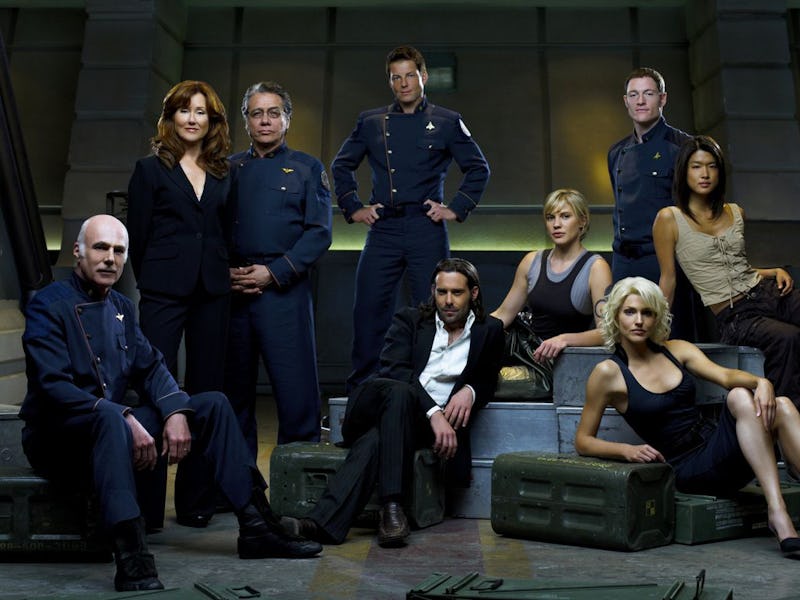Battlestar Galactica’s Ending Remains Terrible — and Perfect
Does the finale hold up? Yes and no.

Even if you’ve never seen the pivotal and groundbreaking Battlestar Galactica reboot, you’re probably still aware the finale was controversial. Like the 2010 Lost finale or the final shot of The Sopranos in 2007, Battlestar Galactica’s final two episodes represent a kind of prestige TV discourse flashpoint. Big, zeitgeist-altering shows don’t always tie up every loose end, and these messy conclusions often dominate the subsequent conversations. With The Sopranos, people can’t stop talking about the meaning of the final shot. With Battlestar Galactica, everyone is hyper-focused on the fate of Katee Sackhoff’s Starbuck, to the point where we sometimes forget all the other good (and not-so-good) stuff that happened in the finale.
On March 20, 2009, the SyFy Channel aired the two-part finale of Battlestar Galactica, “Daybreak Part 2” and “Daybreak Part 3.” It was the perfect finale, in the sense that the vignettes for all the characters truly felt like saying goodbye. But rewatching it today, the finale is tragically flawed because much of it makes no sense.
What happened to Starbuck?
After dying in the episode “Maelstrom,” hotshot pilot Kara “Starbuck” Thrace (Katee Sackhoff) somehow returned in the Season 3 finale, “Crossroads.” Throughout Season 4, trying to figure out how and why she returned got weirder and weirder. In the unofficial Battlestar oral history book, So Say We All, BSG co-creator Ronald D. Moore admits that aspects of Starbuck’s story were less than perfect:
“It did feel like we wandered there a bit; I know we were trying real hard to bring focus into that, and it felt like once you had resurrected her, she had to have a huge storyline that justified that — that it was important to the rest of the show. But I do feel like we never quite brought that into focus.”
In the finale, after the ragtag fleet finds prehistoric Earth — the second Earth in the show’s narrative — the crew starts settling on the planet, attempting to hide themselves from lifeforms who are probably Neanderthals. And although the wildest assertion of the Battlestar finale is easily the panspermic implication that we all evolved from Baltar and Cylon Number Six, the Starbuck mystery baffled fans. Instead of learning how Starbuck returned from the dead, and how she was able to guide everyone to Earth, she simply vanishes.
Starbuck (Katee Sackhoff) and Adama (Edward James Olmos) prepare to depart the Galactica and live on Earth.
After she and Lee (Jamie Bamber) give a tearful goodbye to Adama and President Roslin (Mary McDonnell), Starbuck says she “doesn’t know” where she’s going, but that “I’m done here. I’ve completed my journey, and it feels good.” Then, after a brief flashback, she’s just gone. Was Starbuck a guardian angel? A ghost? A time traveler? A Snuffleupagus that only existed in the minds of all the characters? The BSG writers left it open-ended.
“I can tell you that in the writing room, there were multiple theories as to who Kara Thrace really was,” writer David Weddle said. “We never answered it concretely, nor do I think we ever should. The opinions of the writers in the room are just like the opinions of the viewers.”
This non-answer haunts the show’s reputation, and 15 years later it still sticks out. But what about the rest of the finale?
The Battlestar finale’s greatest strength
Tricia Helfer, as Number Six, memorably closed the series.
There’s something brave about “Daybreak” in that it actually feels like an ending. While there’s some biological wonkiness in making the humans and Cylons our progenitors, the tone of the finale still lands. In the end, the humans and Cylons are forced to go a little more analog and slum it on an undeveloped planet. Instead of evoking Star Trek’s Prime Directive of non-interference, the characters of Battlestar Galactica go back to nature out of necessity. They’re less concerned with the evolution of Earth and more focused on how tired they are of everything that’s happened.
The final moments, which flash-forward to our present and find idealized versions of Baltar (James Callis) and Six (Tricia Helfer) chatting about the series’ cyclical nature, actually land better in 2024 than in 2009. Here, Six contends that this Earth won’t succumb to an AI uprising, but Baltar isn’t so sure.
As the Jimi Hendrix version of “All Along the Watchtower” plays, we see rudimentary robots that existed in 2009. This felt silly 15 years ago, because it was hard to imagine a Cylon uprising. Today, while AI isn’t anything like the Cylons, it’s rapidly transforming everyday life.
At the beginning of Battlestar Galactica, Adama explained to Roslin that the Galactica didn’t use “networked” computers, because the Cylons could use them to hack the ships. He didn’t hate computers; he just wanted control over them. In the finale, as Roslin is dying, they set off into a sunset, concerned only with tactile problems of the body and mind. This bookends the series nicely and demonstrates the power and beauty of Battlestar Galactica. It wasn’t a cautionary tale, but an urgent reminder that good stories are always about people. And in all of science fiction, Battlestar gave us some of the most memorable people of all, even if some of them were robots, or perhaps angels.